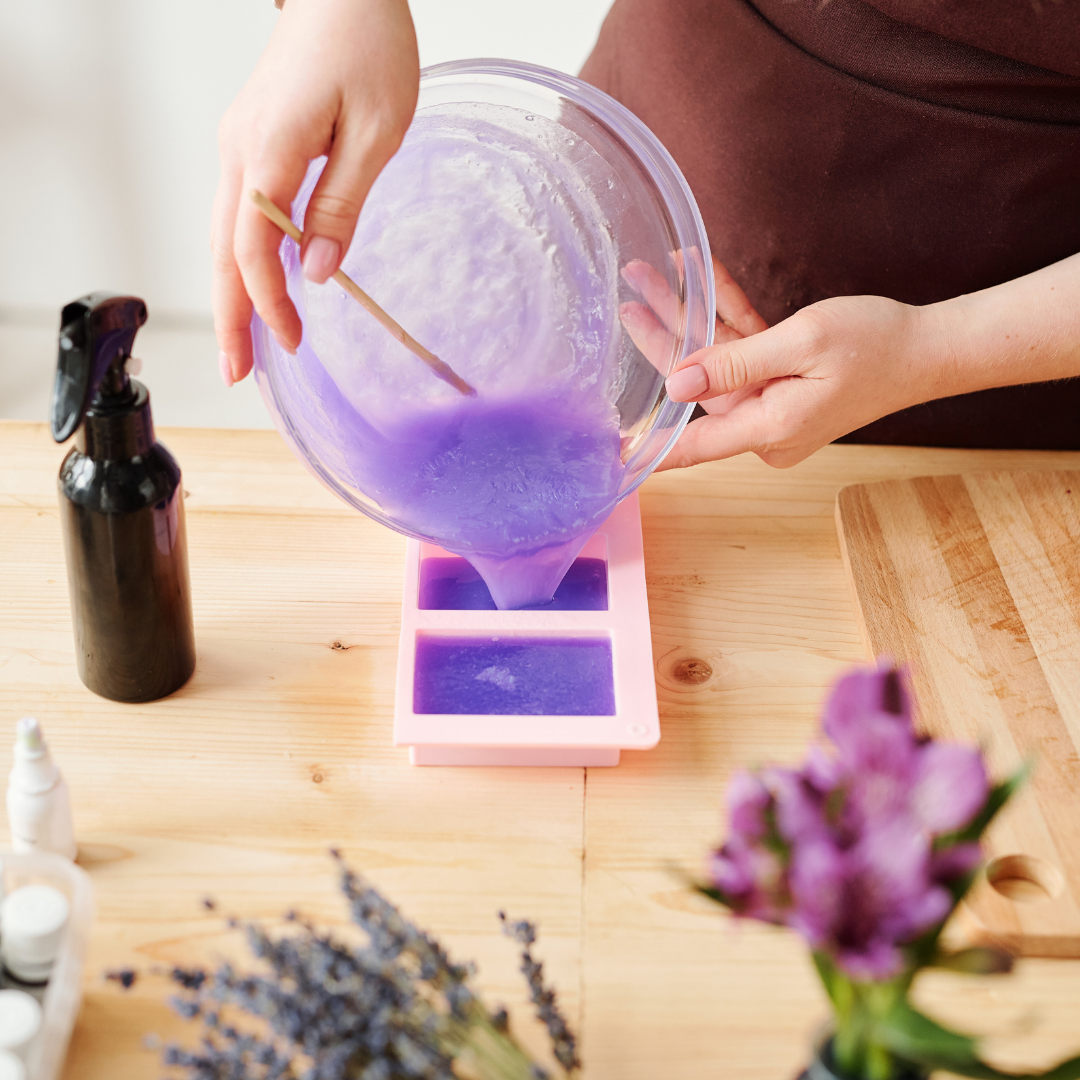
Soap Making for Beginners
Melt and pour soaps is an easy and safe way to make soap without messing around with harmful lye products. It is easy to melt, add your mix ins, and pour into a mold. The soap will be ready to use after just a few hours of cooling. Melt and pour soap contains a high level of glycerin which is known for its moisturizing properties.
What Do You Need to Make Soap?
- Melt and pour soap base
- Microwave
- Knife for shaping
- Microwave safe bowl
- Heat resistant spoon or spatula
- Heat resistant soap mold
- Mix-ins: Essential or fragrance oils, colors, exfoliants, glitters, etc.
- Spray bottle of alcohol
How to Make Soap
- Cut your soap base into small cubes. A pound of base will make 4-6 hand soap sized bars.
- Place the prepared base into a microwave safe bowl, cover it with plastic wrap, and microwave in 20-second intervals, stirring as needed, until mostly melted. The stirring prevents air bubbles.
- Remove from the microwave and stir until completely melted.
- Add your mix-ins. These can be essential oils, fragrance oils, colors, and more.
- Pour the mix into the mold and cover with plastic wrap. Spray air bubbles gently with alcohol.
- Allow the soap to cool inside the mold completely for at least a couple of hours or overnight.
- Release the soap from molds by using a tea towel to prevent denting. If it is sticking, freeze the mold for 15 to 30 minutes, then hold the mold until hot water to release the soap.
*Note: A coating of equal parts petroleum jelly and mineral oil can be heated together and spread into molds to prevent sticking. - Smooth down rough edges with a paring knife or use a clean towel dampened with alcohol.
- Air dry before packing in cellophane or shrink wrap.
Make sure to use the appropriate amount of mix ins. Adding too much of an additive can result in chemical breakdowns that can cause issues. Avoid using fresh ingredients that can spoil in your soap.
What to Put in Your Soap Base?
Colors
Popular cosmetic-grade colorants include oxides, pigments, liquid colorants, micas, and clays. Make sure to use a colorant that is skin-safe and won’t dye the skin. Micas are pearlescent, shimmery powders that can be mixed with a small amount of oil or glycerin. This mix can then be added to your soap base. Clays and herbs can be used to create natural colorings that don’t fade. Clays should be mixed with water before adding to your base to avoid cracking and crumbling. Pigments are powdered dyes that should be mixed with water before adding to your base. Pigments such as oxides and ultramarines leave vibrant colors in your soap.
Moisturizers
Moisturizers such as butters and oils can also be added to your soap base. Moisturizers help the skin to retain moisture and combat dryness and fine lines. Examples include mango, shea, and cocoa butters, rosehip and fractionated coconut oils, and even certain clays like Rhassoul.
Fragrances
When adding scent to your soaps, you can use synthetic fragrance oils or natural essential oils. Scents are added into the warm, melted soaps where they can absorb properly into the base. Fragrance oils can sometimes cause the soap to “weep” or become too oily, so it’s best to test fragrance oils in soaps or use the manufacturer's recommended amounts.
- Fragrance oils: 15ml per pound of soap
- Essential oils: 7ml per pound of soap
Exfoliants
If you’d like to add an exfoliant to your soap, there are a number of good options. Exfoliants help to remove the dead skin cells and reveal healthy, glowing skin. To prevent the exfoliant from separating from the soap base, the mixture needs to be stirred continuously until poured into the molds. Examples of exfoliants include ground oatmeal, jojoba beads, sea salts, sugar, shredded natural loofah, and coffee grounds. In general, add 1-2 tablespoons of exfoliants per pound of soap.
Extracts
Natural plant extracts can add antioxidant properties and vitamins into your soap base. Add 1-2 tablespoons of extract per soap just before pouring into molds. Examples include chamomile, grapefruit, green tea, and papaya extracts.
Melt and pour soaps can be used immediately after drying. Store in a clean, cool, and dark place. Sunlight can break down fragrances, so keeping your soap out of the sun will help it stay fragrant for longer.